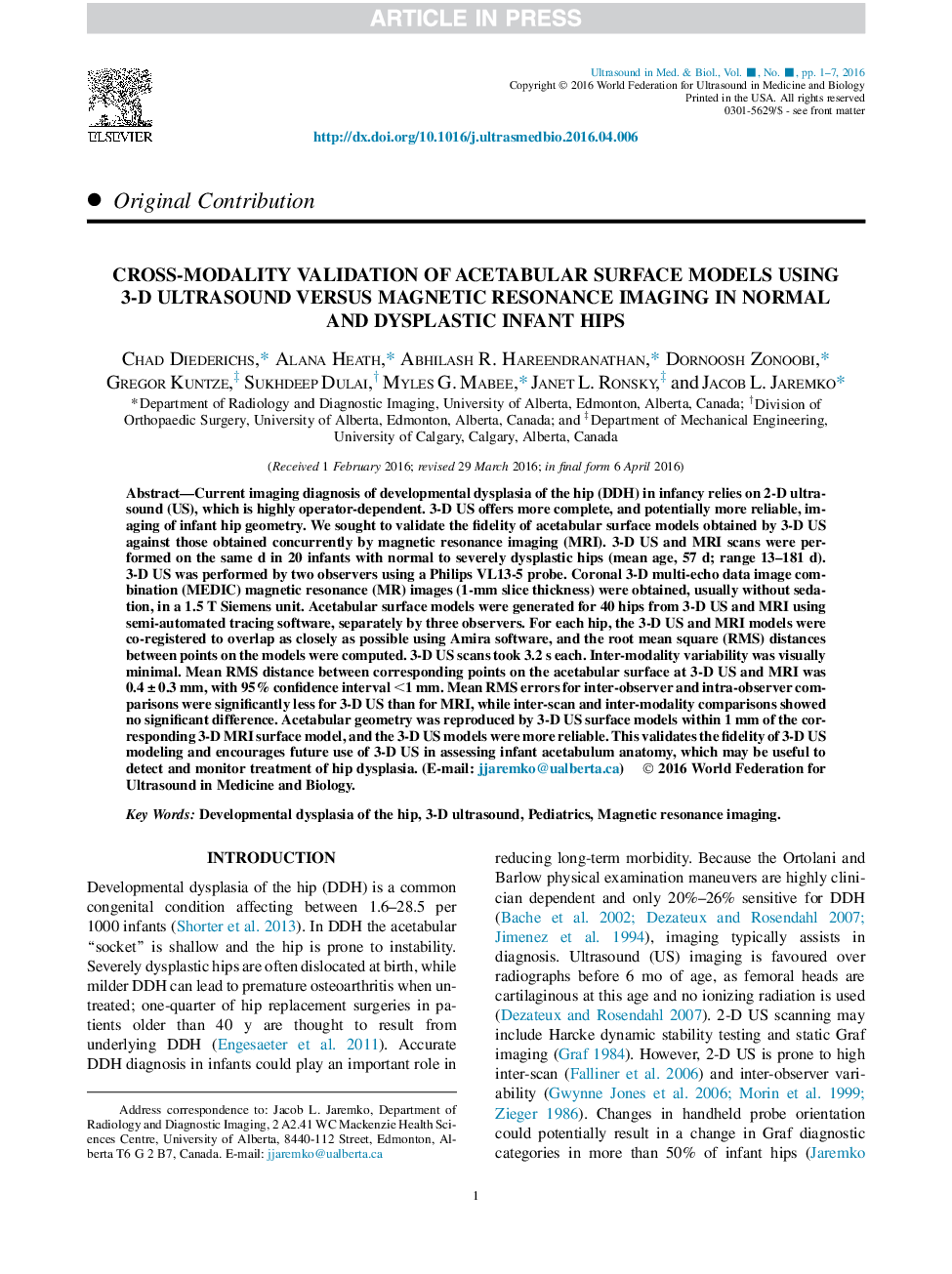| کد مقاله | کد نشریه | سال انتشار | مقاله انگلیسی | نسخه تمام متن |
|---|---|---|---|---|
| 10691065 | 1019580 | 2016 | 7 صفحه PDF | دانلود رایگان |
عنوان انگلیسی مقاله ISI
Cross-Modality Validation of Acetabular Surface Models Using 3-D Ultrasound Versus Magnetic Resonance Imaging in Normal and Dysplastic Infant Hips
ترجمه فارسی عنوان
اعتبار سنجی متقابل مدل های سطحی استابلل با استفاده از اشعه ماوراء بنفش در مقابل توموگرافی رزونانس مغناطیسی در بطن های نوزادان نرمال و پلاستیک
دانلود مقاله + سفارش ترجمه
دانلود مقاله ISI انگلیسی
رایگان برای ایرانیان
کلمات کلیدی
دیسپلازی رشدی ران، سونوگرافی 3 بعدی، اطفال، تصویربرداری رزونانس مغناطیسی،
موضوعات مرتبط
مهندسی و علوم پایه
فیزیک و نجوم
آکوستیک و فرا صوت
چکیده انگلیسی
Current imaging diagnosis of developmental dysplasia of the hip (DDH) in infancy relies on 2-D ultrasound (US), which is highly operator-dependent. 3-D US offers more complete, and potentially more reliable, imaging of infant hip geometry. We sought to validate the fidelity of acetabular surface models obtained by 3-D US against those obtained concurrently by magnetic resonance imaging (MRI). 3-D US and MRI scans were performed on the same d in 20 infants with normal to severely dysplastic hips (mean age, 57 d; range 13-181 d). 3-D US was performed by two observers using a Philips VL13-5 probe. Coronal 3-D multi-echo data image combination (MEDIC) magnetic resonance (MR) images (1-mm slice thickness) were obtained, usually without sedation, in a 1.5 T Siemens unit. Acetabular surface models were generated for 40 hips from 3-D US and MRI using semi-automated tracing software, separately by three observers. For each hip, the 3-D US and MRI models were co-registered to overlap as closely as possible using Amira software, and the root mean square (RMS) distances between points on the models were computed. 3-D US scans took 3.2 s each. Inter-modality variability was visually minimal. Mean RMS distance between corresponding points on the acetabular surface at 3-D US and MRI was 0.4 ± 0.3 mm, with 95% confidence interval <1 mm. Mean RMS errors for inter-observer and intra-observer comparisons were significantly less for 3-D US than for MRI, while inter-scan and inter-modality comparisons showed no significant difference. Acetabular geometry was reproduced by 3-D US surface models within 1 mm of the corresponding 3-D MRI surface model, and the 3-D US models were more reliable. This validates the fidelity of 3-D US modeling and encourages future use of 3-D US in assessing infant acetabulum anatomy, which may be useful to detect and monitor treatment of hip dysplasia.
ناشر
Database: Elsevier - ScienceDirect (ساینس دایرکت)
Journal: Ultrasound in Medicine & Biology - Volume 42, Issue 9, September 2016, Pages 2308-2314
Journal: Ultrasound in Medicine & Biology - Volume 42, Issue 9, September 2016, Pages 2308-2314
نویسندگان
Chad Diederichs, Alana Heath, Abhilash R. Hareendranathan, Dornoosh Zonoobi, Gregor Kuntze, Sukhdeep Dulai, Myles G. Mabee, Janet L. Ronsky, Jacob L. Jaremko,
